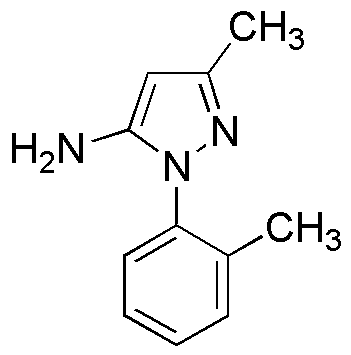3-Methyl-1-(2-methylphenyl)-1H-pyrazol-5-amine is widely utilized in research focused on:
- Agricultural Chemistry: This compound serves as a key intermediate in the synthesis of agrochemicals, particularly herbicides and fungicides, helping to enhance crop yields and protect against pests.
- Pharmaceutical Development: It is explored for its potential as a pharmaceutical agent, particularly in the development of drugs targeting specific diseases, owing to its unique chemical structure that may interact favorably with biological targets.
- Material Science: The compound is used in the formulation of specialty materials, such as polymers and coatings, where its properties can improve durability and resistance to environmental factors.
- Analytical Chemistry: It acts as a reagent in various analytical techniques, aiding in the detection and quantification of other compounds, which is crucial for quality control in manufacturing processes.
- Research in Organic Synthesis: This chemical is valuable in organic synthesis as a building block, allowing researchers to create complex molecules more efficiently, thus speeding up the discovery of new compounds.
General Information
Properties
Safety and Regulations
Applications
3-Methyl-1-(2-methylphenyl)-1H-pyrazol-5-amine is widely utilized in research focused on:
- Agricultural Chemistry: This compound serves as a key intermediate in the synthesis of agrochemicals, particularly herbicides and fungicides, helping to enhance crop yields and protect against pests.
- Pharmaceutical Development: It is explored for its potential as a pharmaceutical agent, particularly in the development of drugs targeting specific diseases, owing to its unique chemical structure that may interact favorably with biological targets.
- Material Science: The compound is used in the formulation of specialty materials, such as polymers and coatings, where its properties can improve durability and resistance to environmental factors.
- Analytical Chemistry: It acts as a reagent in various analytical techniques, aiding in the detection and quantification of other compounds, which is crucial for quality control in manufacturing processes.
- Research in Organic Synthesis: This chemical is valuable in organic synthesis as a building block, allowing researchers to create complex molecules more efficiently, thus speeding up the discovery of new compounds.
Documents
Safety Data Sheets (SDS)
The SDS provides comprehensive safety information on handling, storage, and disposal of the product.
Product Specification (PS)
The PS provides a comprehensive breakdown of the product’s properties, including chemical composition, physical state, purity, and storage requirements. It also details acceptable quality ranges and the product's intended applications.
Certificates of Analysis (COA)
Search for Certificates of Analysis (COA) by entering the products Lot Number. Lot and Batch Numbers can be found on a product’s label following the words ‘Lot’ or ‘Batch’.
*Catalog Number
*Lot Number
Certificates Of Origin (COO)
This COO confirms the country where the product was manufactured, and also details the materials and components used in it and whether it is derived from natural, synthetic, or other specific sources. This certificate may be required for customs, trade, and regulatory compliance.
*Catalog Number
*Lot Number
Safety Data Sheets (SDS)
The SDS provides comprehensive safety information on handling, storage, and disposal of the product.
DownloadProduct Specification (PS)
The PS provides a comprehensive breakdown of the product’s properties, including chemical composition, physical state, purity, and storage requirements. It also details acceptable quality ranges and the product's intended applications.
DownloadCertificates of Analysis (COA)
Search for Certificates of Analysis (COA) by entering the products Lot Number. Lot and Batch Numbers can be found on a product’s label following the words ‘Lot’ or ‘Batch’.
*Catalog Number
*Lot Number
Certificates Of Origin (COO)
This COO confirms the country where the product was manufactured, and also details the materials and components used in it and whether it is derived from natural, synthetic, or other specific sources. This certificate may be required for customs, trade, and regulatory compliance.


